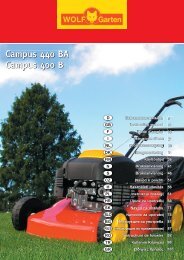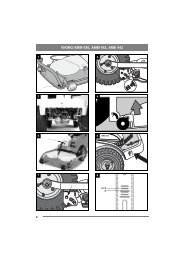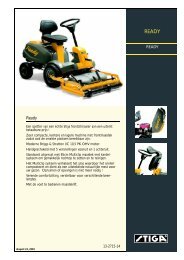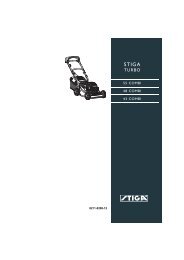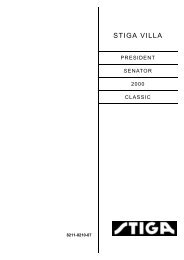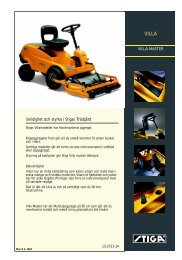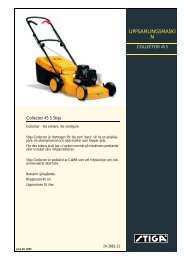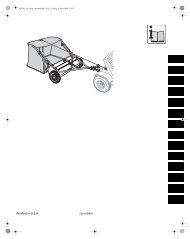STIGA PARK
STIGA PARK
STIGA PARK
You also want an ePaper? Increase the reach of your titles
YUMPU automatically turns print PDFs into web optimized ePapers that Google loves.
68<br />
EN<br />
The oil level must never exceed the “FULL” mark.<br />
This results in the engine overheating. If the oil<br />
level exceeds the “FULL” mark, the oil must be<br />
drained until the correct level is achieved.<br />
4.3 Safety checks<br />
Check that the results of the safety checks below<br />
are achieved when testing the machine in question.<br />
The safety checks must always be carried<br />
out every time before use.<br />
If any of the results below is not<br />
achieved, the machine must not be<br />
used! Take the machine to a service<br />
workshop for repair.<br />
4.3.1 General safety check<br />
Object Result<br />
Fuel lines and con- No leaks.<br />
nections.<br />
Electrical cables. All insulation intact.<br />
No mechanical damage.<br />
Exhaust system. No leaks at connections.<br />
All screws tightened.<br />
Oil lines No leaks. No damage.<br />
Drive the machine The machine will stop.<br />
forwards/backwards<br />
and release<br />
the driving-service<br />
brake pedal.<br />
Test driving No abnormal vibrations.<br />
No abnormal sound.<br />
4.3.2 Electrical safety check<br />
The operation of the safety system<br />
should always be checked every time<br />
before use.<br />
Status Action Result<br />
The clutch-brake<br />
pedal is not<br />
depressed.<br />
The power take-off<br />
is not activated.<br />
The clutch-brake<br />
pedal is depressed.<br />
The power take-off<br />
is activated.<br />
Engine running.<br />
The power take-off<br />
is activated.<br />
Try to start. The engine<br />
will not start.<br />
The driver gets up<br />
from the seat.<br />
The driver gets up<br />
from the seat.<br />
Engine running. Remove fuse 10<br />
A.<br />
See fig. 13.<br />
The engine<br />
will not start.<br />
The power<br />
take-off will<br />
be disen-<br />
gaged.<br />
The engine<br />
will stop.<br />
ENGLISH<br />
Status Action Result<br />
Cruise control activated.<br />
The driver gets up<br />
from the seat.<br />
The cruise<br />
control will<br />
be disen-<br />
gaged.<br />
Cruise control acti- The clutch-brake The cruise<br />
vated.<br />
pedal is depressed. control will<br />
be disengaged.<br />
The switch for the Try to engage the It will not be<br />
implement lifter is power take-off. possible to<br />
in neutral position.<br />
engage the<br />
(not Pro16)<br />
power takeoff.<br />
4.4 Start<br />
1. Open the fuel cock. See 14.<br />
2. Check that the spark plug cable(s) is/are installed<br />
on the spark plug(s).<br />
3. Check to make sure that the power take-off is<br />
disengaged.<br />
4. Do not keep your foot on the drive pedal (3:F).<br />
5. Put the throttle control at full throttle.<br />
Starting cold engine – pull the choke control out<br />
fully.<br />
Starting warm engine – the choke control<br />
should be pressed in.<br />
6. Depress the clutch-brake pedal (3:B) fully.<br />
7. Turn the ignition key and start the engine.<br />
8 Once the engine has started, push the choke<br />
control in gradually if it has been used.<br />
9. When starting from cold, do not make the machine<br />
work under load immediately, but let the<br />
engine run for a few minutes first. This will allow<br />
the oil to warm up.<br />
When the machine is in operation, full throttle<br />
should always be used.<br />
4.5 Power assisted steering<br />
(Pro20, Pro25, Pro Svan)<br />
Power assisted steering means that power from the<br />
machine’s hydraulic system is supplied to the<br />
steering wheel movements. This makes the machine<br />
very easy to steer when the engine is operating<br />
at working revs (full throttle).<br />
The servo effect is reduced as the engine speed<br />
drops.<br />
4.6 Operating tips<br />
Always check that there is the correct volume of<br />
oil in the engine. This is particularly important<br />
when operating on slopes. See 4.2.



